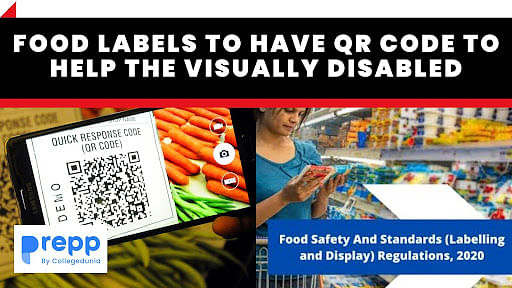November 1, 2023
FSSAI Introduces QR Codes on Food Products for Enhanced Safety and Accessibility

Introduction:
- The Food Safety and Standards Authority of India (FSSAI) has taken a significant stride towards ensuring food safety and accessibility, particularly for visually impaired individuals, by recommending the incorporation of QR codes on food products. This move holds great significance in a country with one of the world’s largest markets for packaged foods and a growing burden of non-communicable diseases (NCDs) primarily driven by the consumption of pre-packaged foods.
QR Code Implementation by FSSAI:
Comprehensive Data Inclusion:
- The QR codes will encompass a wealth of product information, ranging from ingredients and nutritional facts to allergens, manufacturing date, expiry details, allergen warnings, and customer contact information.
Alignment with Regulations:
- This initiative is in complete alignment with the FSSAI’s Food Safety and Standards (Labelling and Display) Regulations, 2020, as well as the Rights of Persons with Disabilities Act, 2016. It places a strong emphasis on accessibility for individuals with disabilities.
Origins of QR Codes:
Invention and Purpose:
- In 1994, the Japanese company Denso Wave invented QR codes, two-dimensional matrix barcodes, primarily for labelling automobile parts.
Benefits for Food Manufacturers:
- For food manufacturers, QR codes offer a range of advantages, including bolstering brand image, fostering customer loyalty, and enhancing operational efficiency.
Significance of the Initiative:
Addressing India’s Market Dynamics:
- Given India’s burgeoning market for packaged foods and the concurrent surge in NCDs, providing consumers with informed choices becomes imperative.
Empowering Consumer Rights:
- This initiative empowers consumers to make well-informed decisions and verify if a product lives up to its advertised attributes.
Advocating for Comprehensive Labelling:
- It is recommended that the FSSAI combine QR codes for visually impaired individuals with front-of-pack labelling (FOPL) warning labels, ensuring a holistic approach to information accessibility.
Global Trends in QR Usage:
Leading Adopters:
- Countries like the U.S., India, France, and the U.K. stand at the forefront of QR code usage, showcasing its widespread acceptance.
Driving Market Growth:
- The global packaged food market, valued at $303.26 billion in 2019, continues its expansion, with QR codes playing a pivotal role in providing consumers with vital product information.
Influencing Consumer Preferences:
- Consumers now view food packaging as equally important as the product itself, with QR codes serving as a technology that facilitates information accessibility and significantly impacts buying behavior.
Conclusion:
- The introduction of QR codes on food products by the FSSAI marks a crucial step towards enhancing food safety and ensuring consumers have access to comprehensive product information. In an era of escalating health concerns and burgeoning markets for packaged foods, this initiative empowers consumers to make well-informed choices and underscores the vital importance of transparent food labelling. QR codes are not only emerging as a global trend but also simplifying information access and augmenting consumer experiences.
Daily Gist : The Hindu/Indian Express : 30 Jan 2025
January 30, 2025
Gist of editorial : the Hindu/ Indian Express/20 Jan 2025
January 20, 2025
Daily the Hindu/ Indian Express Editorial Gist: 14 Jan 2025
January 14, 2025
